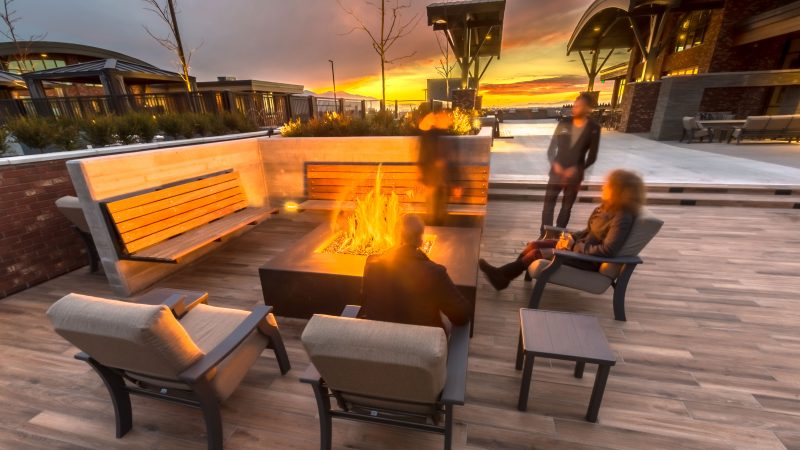We love architecture and we love working with architects. It’s no secret that there’s sometimes tension in the architect/landscape architect relationship, but there’s no reason it needs to be that way. The duo will always create a better project together when they work as a team in harmony. Over the years, we’ve successfully navigated many projects and relationships and we’ve listened to what architects say about what rings their bell and what pushes their buttons. To lay the foundation, here are five guidelines for working with architects that will help you become their ‘go-to’ landscape architect, time after time.
- Be responsive to deadlines
It’s tempting to say “never miss a deadline”, but never missing a deadline requires that you recognize when time seems short and respond to that. Every business is juggling all the time and consistently re-prioritizing in an effort to make things run smoothly despite variables. Your top priority today may not be the same as your top priority tomorrow. But still, there are deadlines all the time, sometimes more than one on the same day. When this happens and your collar starts feeling tight, pick up the phone and ask the architect for the latest possible date of delivery. Often times there’s some flexibility built into the timeline because most professionals are all too familiar with the need for wiggle room and thus pad deadlines from the beginning.
Even if it’s a hard deadline, you never know when another factor has changed on the other end and the architect needs an extra day as much as you do. In either case, by giving them a heads-up as soon as you recognize you might need to push a deadline out, the open communication will be well-received. It’s when you wait until the last minute––or the actual deadline––to inform them you won’t meet it that you create more problems and inflame the architect and probably others. By asking for more time, you can effectively re-establish a deadline and by doing so, you won’t miss it. Having said that, surely you want to aim to meet those original deadlines the best you can each time so that when you need flexibility it won’t be a case of here he goes again asking for more time.

4th West Apartments designed by Loft Six Four
2. Make their life easier
When we make the architect look good it makes their life easier by way of eliminating the need to prove themselves. The key to making their life easier is always having their perspective in mind and recognizing that they’re the client and you’re here to solve problems for them, not create problems or friction. You can do this by doing your job well, communicating, being proactive throughout the process, not missing deadlines, building trust, and collaborating with them.
The main goal is to remove as many obstacles as possible, even in things that seem mundane. When you send an email, make sure they don’t have to read a lengthy message and extract from it what you need. Put any requests or items that need a response in a list format or a clear statement of what you need and when you need it. This way you can avoid miscommunications or the need to go back and forth multiple times to clarify. All of these smaller efforts add up to a well-run project and ultimately a stellar end result that everyone is proud of. You want the architect, and everyone, to walk away feeling light about the entire project, knowing that they can count on you to deliver, to be creative, to communicate well, to alleviate stress, and always have their back.

4th West Apartments designed by Loft Six Four
3. Make them look great to their clients
Too often we have our own agendas, we’re in our own world and in silos of doing our own thing and we forget to see things from another’s standpoint. Whenever we’ve taken heat from an architect it usually comes down to a few simple things: either they feel the heat from their owners or client, we haven’t delivered something we said we would, or maybe we’ve missed something in the documentation resulting in miscommunications or mismanaged expectations. Really understanding who the architect is and making them look great to the people paying the bills is key. Be aware of the bigger picture enough to check in along the way be sure everyone is on track. Ask yourself, “How do we make the architect look good, how do we make their lives easier?” This includes handling problems well that may come up along the way. If an architect calls with a problem they’re having and you can help them, it often strengthens the relationship, builds trust, and lets them rest easy knowing they can count on you.
A favorite example of making the architects look great to their clients and making their life easier is something that became one of our company’s core values that we call Pay for the Palm, meaning do what it takes. An architect had a project where the client specifically asked for 14-foot palm trees in the programming document, but somehow they didn’t get translated into the drawings. The drawings indicated 10-foot palms, so the landscape contractor installed 10-foot palm trees. The client was very frustrated and held us to the original request. We looked through the documentation and couldn’t find anything on 14-foot trees, the drawings all said 10-foot and the architect had our back. The client was adamant about 14-foot palms––which was a $10k difference to replace. The architect called us and asked to help them make a concession for the client and asked if we’d help pay for, or pay for, the palm trees out of our pocket. We said that yes, of course, we would. This architecture firm is a great client of ours, we have a great relationship, and they bring us a lot of great work, so we wanted them to be able to say to the client that the palms would be replaced with no problem. Writing that check felt like a lot, but it has paid dividends. In the end, we knew it’d be worth it to maintain that relationship and retain the lifetime value of the client. To go out and acquire new architect clients and replace all the potential work that it can lead to is far more costly. Do what you can to hold on to a great collaborative relationship with an architect you know, like, and trust.
4. Seek the right answer, not to be right
Collaboration is critical to success and whenever one person on your team is consistently trying to own the floor or to be right, it hinders everyone else. The end products of the best projects are a combination of feedback from both sides, no one directing the other, but rather everyone leaving their expectations at the door. It’s good to go in with a vision and an idea, but be open to the input of others and different iterations that it might take on. The answer or end result might be very different than what you originally imagine and guaranteed to be at least a little different. Take other points of view into account – everyone has a different perspective from the vantage point of their expertise. It’s a combination of all that input and allowing the architecture design and landscape architecture to influence each other that generates an outstanding design. Sometimes you go into a project with a particular idea and find that a better solution exists. Architects will advocate for you as much as you advocate for them, but it has to make sense for the project. A pain point for them is that it’s difficult to argue on your behalf if the scope of what you’re proposing for a project doesn’t somehow relate to the betterment of the architecture. This is where you need to be flexible with your vision. There has to be more of a purpose than just being pretty and everything needs to truly integrate with the use and appearance of the architecture.
On one project we found that what worked and looked best was simple, minimal landscape design. Sometimes less is more. It’s not about being showy about what you can do, but being in tune with the architecture and designing something that is seamless. It’s a good sign if you can’t immediately see what the landscape architect did because it’s so intuitively laid out. Everyone on the team plays a part in making that happen and when it’s well-blended, it’s hard who tell who did what. If you’re doing your job well, you’ll make more seamless transitions, especially when there’s indoor and outdoor space, making it as if they are part of each other. You can do this by being open to what are truly the most essential components of the space.
5. The architect is the hero
True success requires that you have your own voice and style but work with people in a way that highlights the architecture. Architects want to know that you’re creative and have your own sensibilities but that you work to let the architecture be the star. Think of yourself as the guide that helps the hero––the architect––achieve greatness. Creativity is not necessarily a given with landscape architecture, some landscape design is more heavily based on the engineering of components which is very useful, but it’s creativity that makes it special. It’s hard to put your finger on, but it’s what makes the work valuable. This creative vision includes the ability to see how you can make the architect and the architecture the hero as part of the creative process, not just engineering something functional.

An overview of the 4th West Apartments designed by Loft Six Four
When you give a client what they want, it yields a better result, but that doesn’t mean you have to be limited to only what they say. Take your intuitive sense for design and your expertise to filter what they ask you for. What they request may not be exactly what you give them, it’s up to you to come up with something that’s inventive. If you hit all the main points the architect requests and imagine a space that’s seamless, that’s what matters. There’s value in the fact you have an understanding of architecture in a way that allows you to read between the lines and translate the architect’s vision into a plan that makes the architecture and the landscape architecture harmonious. In many cases, your translation may offer elements that they haven’t considered or are unfamiliar with. By mixing the specifics they want with creative ideas about how to deliver those in the project, you’ll demonstrate that you care, you listen to your clients, and you deliver what they want while highlighting the architect’s work.
As with any professional or personal situation, having the best relationship and success requires good communication, integrity, and humility. When these attributes are combined with an amazing skill set, you have a winning recipe for success that will pay dividends with repeat work with the architects and projects you love to work on the most.
—
Lead Image: 4th West Apartments (Salt Lake City, UT ) designed by Loft Six Four




luke hegeman
“This creative vision includes the ability to see how you can make the architect and the architecture the hero as part of the creative process”… F*** making an architect a hero. We, the collective minds that invent and manipulate space, do it as a team. We, as landscape architects, are hired to create compositions that promote the health, safety, and public welfare of those that use our spaces. To that end, if we follow your first five steps we are now on a well-functioning, communicative team that has an unified vision towards making said space a successful project – no hero needed.
Landscape architects are not beholden to architects and we should make every effort to strengthen our profession instead of promulgating subservience to architecture.
Aybige Tek
Agreed to this! Even though i am an architect. I still believe without a proper landscape; architecture don’t mean nothing 🙂 Great points. Thank you guys.
Brandon Reed, CVO, ASLA / Rooftop and Urban Designer / Landscape Architect
Thanks Aybige!
Brandon Reed, CVO, ASLA / Rooftop and Urban Designer / Landscape Architect
Hey Luke. Thanks for making the time to share your strong opinion on our article. I do have to say that the whole point of the article was not to say that we should be beholden to architects, rather to break the very notion and negative feelings that you expressed in your comments…that somehow architects and landscape architects should be at odds with each other…..rather if you are a talented Landscape Architect and have something to contribute to a project the Architects will take note and will respect and want you on their project….That all begins with confidence in your own abilities to express yourself through good design….and you have to go into any project scenario with a positive attitude that fosters the search for the right solution(s) rather than being right….Its the collaborative effort of the team that always yields a better result….that includes the whole team involvement and not just the architect and landscape architect.
Also, this article was written from the point of view that the architect is your client and the one that hired you. In this scenario, if you don’t treat your client as the hero then you won’t last long in your job and/or business…..this philosophy would ring true in any scenario where someone hires you. Check out https://storybrand.com/ if you’re wondering where we learned this philosophy on making the client “the architect” in this case the hero…I can tell you it works beautifully…And in this scenario, I would confidently tell you that if you had the attitude you portrayed in your above comment you should be fired immediately!
If you’re in the project lead and the architect doesn’t bring a collaborative attitude to the project then you probably hired the wrong architect in the first place.
And finally if you’re not working with architects that value what you as the landscape architect bring to the table between your design approach and expertise then you need to align yourself with architects that value what you bring to the table….and chances are you may not be offering them much to value in the first place….as soon as we began to align ourselves with architects that shared our same values we soon began to have a much better experience where the architect looked to us to help guide them to how to help make their architecture better and also bring creative solutions to the exterior site and how to harmonize all of the above….if you’re doing these things then you’ll rarely have those negative experiences…..its never going to be absolutely perfect but you have to also bring the positivity and belief that you’re going to deliver this type of experience every time….regardless of how the architect acts at any given moment….Architects are our allies and need to be treated as such or you’ll always encounter these problems….and if you continually encounter these types of problems then I would venture to say the common denominator in these scenarios is you so take a good look in the mirror and ask yourself ….”what can i do to deliver such great design and attitude that the architects can’t deny our relevance, expertise, design acumen, and passion and positivity”
All things being equal from you and your competitor Landscape Architect…..the one that is the most likable will get the work….people want to work with people they know like and trust…..
These are all my opinions and experiences over the last 18 years in practice….so take them for what they’re worth but they’ve paid us huge dividends and attracted the right architects and projects.
For your reference, if you want a prime example of a rock star LA who collaborates with top architects around the world check out… https://www.coenpartners.com/home . Shane Coen is a master collaborator LA who unifies architecture as good as anyone Ive ever seen….
Cheers
Tim Daugherty
There are some good business development lessons in here, but I would apply it to any client – whether it’s a public agency, developer, architect, planner or civil engineer. I think many LA’s will be put off by #5, which could have easily just been “The Client is the Hero”.
Brandon Reed, CVO, ASLA / Rooftop and Urban Designer / Landscape Architect
Thanks for your comment @tim daugherty. I like your feedback and yes that is a good option to replace the “architect as the hero” to the client is the hero. Much appreciated!
Woodman336
Can you write an article on an Architecture network site about 5 thing LAs want from an architect with the same subservient language? That would make me feel better. Thanks.
Brandon Reed, CVO, ASLA / Rooftop and Urban Designer / Landscape Architect
That’s a great idea @Joshua
Brandon Reed, CVO, ASLA / Rooftop and Urban Designer / Landscape Architect
I would love to hear what 5 things you want from an architect?